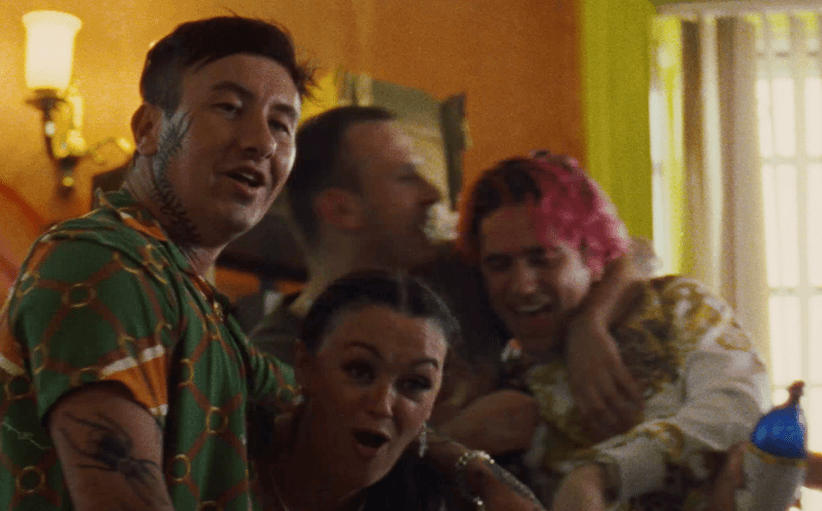Comment: On Dean Blunt and unanswerable questions
This piece was doomed from the start. To try to define Dean Blunt, shrouded by a web of cryptic in-jokes and obscure influences, is impossible. From the near-seven-minute soundscape of a thunderstorm field recording, dripping water and a warbling off-tune organ line in ‘The Narcissist II’’s DIRECT LINE to the obtuse non-music of standalone “single” X-Tasy, the London-bred chameleon has been developing an aura of artistic ambiguity and ambivalence ever since Hype Williams’ uneasy oeuvre of performance art-meets-music emerged as an offhanded affront to the world. A sullen deconstruction of information mediation, Blunt and his indivisible Hype Williams companion, Inga Copeland, took the raw tools of primitive hardware, an undeveloped skill set and infinite data access to dissect popular culture for all its ugliness and absurdity, through their technique of crude yet sensuous pastiche.
Four years later and the band have mutated, built on their mutual past and launched towards an increasingly divergent future. Casually splitting into “Dean Blunt and Inga Copeland” and releasing ‘Black is Beautiful’ LP last year, the former was the first to strike out on his own under the pseudonym (one of many) with the ‘Jill Scott Herring’ cassette in 2011. Sticking closest to the duo’s coarse aesthetic and playful cultural references – rooted in punk and dub, grime and R&B – was the moody romance of 2012’s ‘The Narcissist II’, which plays out over wistful soul samples and spoken sound bites in an unhinged audio collage heard through a haze of blown-out drones. A faltering vocal implores, “let’s not start a war,” before vanishing into a troubling depiction of domestic abuse. That same album’s title track, featuring Copeland, is the sound of inner-city loneliness, evoking a similar sense of desolation and melancholy as the late Gil Scott-Heron’s New York is Killing Me, in which he moans, “you got eight million people/ and I didn’t have a single friend”. Blunt echoes the sentiment through the void left behind by a broken relationship as he says, “I wanna hold you”, before dissociating himself from too much sincerity, characteristically privileging the notion of art as artifice with a field recording of audience applause, transposed by that of someone smoking a joint.
Dean Blunt and Inga Copeland – The Narcissist
The significance of Dean Blunt and Hype Williams (because the two are inextricably linked) has rarely been explored in great detail. Perhaps it’s for fear of falling victim to that Great Hoax that these two jokers must surely be in on. If that’s the case, it’s an elaborate prank to pull, and a fair commitment to make just for the sake of it. It could also be in response to Blunt’s explicit antagonism toward press; a respect for and complicity with an artist’s wishes whose own anti-intellectual attitude runs through everything he’s produced. Whatever the motivation, it shouldn’t be forgotten just how culturally relevant Dean Blunt is today. From his flat-out refusal to publicly explain his work, to consciously frustrating and subverting his processes through fragmentation, contradiction and subversive humour, his sound functions on an anxious undercurrent of self-reflexivity, which is what makes him so interesting.
“From his flat-out refusal to publicly explain his work, to consciously frustrating and subverting his processes through fragmentation, contradiction and subversive humour, his sound functions on an anxious undercurrent of self-reflexivity.”
There’s a brilliant Finnish artist, Jaakko Pallasvuo, whose narrator in his ‘Icarus’ (2012) video verbalises the hyper-conscious skepticism of the modern condition by saying, “If we could really communicate, there would be no need to communicate.” That’s a notion that certainly applies to Dean Blunt. His divisive approach to his practice (and it is an art practice) could either provoke outrage in what FACT describes as “that conceited obfuscation of [his] own identities and strategies”, or a fetishistic cult of personality based around unmasking the man behind the myth. But then, if there ever was going to be a point, that very befuddlement would be it. As Blunt himself says in a revealing ‘Invisible Jukebox’ transcript with The Wire’s Lisa Blanning in 2011, “people seem to want everything really spelled out for them,” continuing that he’d rather not underestimate his audience’s intelligence, instead opting to make them do some of the work themselves, becoming more engaged in the meantime.
Icarus, 2012 from Jaakko Pallasvuo on Vimeo.
In all the limited-run physical releases, mutating stage plays and art exhibitions, not mentioning those notoriously unpredictable live performances, you could never fully know Dean Blunt’s work. It’s a notion that he himself engenders, as invigilators at his recent ‘Brixton 28s’ exhibition actively concealed the fact of a surprise live performance by Jstar Valentine (a music fan who uploads a capella versions of his favourite tracks, which include ‘The Narcissist’) at its opening. The “world premiere” of live production ‘Dean Blunt presents The Narcissist’ in Berlin featured none of that homonymous album’s material, instead showcasing some from the forthcoming ‘The Redeemer’ and elements of his play, ‘Lord Knows’.
That’s because Dean Blunt is a perpetual work-in-progress. As contemporary media theorist Mark Federman writes, “the future, especially for emerging societies, is always elsewhere, constantly in flux, formed according to relational, as opposed to regional patterns”. Blunt’s output is assembled from reused and recycled material –uncredited covers, recontextualised samples and musical metanarratives –all of which are as indistinguishable from their original context, as the identities of Dean Blunt and Hype Williams are conjoined; the work they produce mutually dependent. A rap that appears in Hype William’s ‘London 2012’ mix and is delivered by an unknown performer surfaces again in Blunt’s ‘The Narcissist II’, this time recited by himself, while the sample of applause in The Narcissist (feat Inga Copeland) is the same one from ‘The Attitude Era’. Hype Williams becomes “Dean Blunt and Inga Copeland” becomes Hype Williams, while all involved upload music to a shared Soundcloud account, ‘CPLND’, and YouTube videos on the channel ‘Polly Jacobsen’ while releases come through their wryly-titled label, World Music. All this not only serves to illustrate their creative processes but it further blurs the distinction between projects, thereby removing the role (and significance) of artist from that process altogether.
“Dean Blunt’s work is no more his as it is his audience’s, and it’s up to us to interpret, respond to and interact with it as we choose.”
It echoes that idea of “pseudo” or “digi” modernism, defined by cultural critic Alan Kirby as text created “by the audience, for the audience”. That concept is more in reference to crowd sourcing, active participation and intervention being integral to the creation of a text – but, in being as much a product of the mass media as a reaction to it, Blunt speaks through this new form, if not critically. That could be why you have X-Tasy –an unlisted teaser track, released in the lead up to ‘The Redeemer’ – featuring a sub bass signal that’s impossible to hear through computer speakers, thus challenging his core audience to leave cyberspace and experience it in the context of the wider world. It’s also how the influence of Jstar Valentine’s video response manifested itself as a live performance at ‘Brixton 28s’, as well as a role in Blunt’s as-yet-to-be-staged play, ‘Im Just Passin Thru To Show Some Love’. Dean Blunt’s work is no more his as it is his audience’s, and it’s up to us to interpret, respond to and interact with it as we choose.
Dean Blunt – X-Tasy/EDDIE PEAKE WET DREEM
That’s why I don’t think finally hearing ‘The Redeemer’’s I Run New York on May 1st will alter the connection I’ve made between the opening track title and the Angel Haze song of the same name, with its Scott-Heron sample from New York is Killing Me, which in turn also happens to remind me of The Narcissist (feat Inga Copeland). As Blunt himself says in admiration of David Lynch’s refusal to explain his surreal oeuvre, “it’s like that complete freedom to watch something and take it in and be given the privilege to completely make up what you want from it.”
“Whether it’s ‘good’, it’s not the point, it’s the truth.” – Dean Blunt
Because who cares that the volume was up so high at the ICA’s ‘The Redeemer’ listening session that it distorted the sound, or that you can see Blunt’s two leads reading from a script in his play ‘Lord Knows’? In the same way that Dean Blunt and Inga Copeland’s ‘The Attitude Era’ presented sundry sketches, demos and field recordings that have reappeared in countless releases since, Blunt’s work is all about process. A fragmentary collection of unfinished vignettes, half-formed ideas and incidental events, it’s up to us to ask the questions and come up with our own answers.
Like: why does the the X-Tasy video come accompanied by a link to a Wikipedia page on the ‘Magical Negro’ trope, and what’s interesting about a terrible live recording of James Ferraro and Dean Blunt being drowned out by extraneous chatter in Watch the Throne? Should I be amused or horrified by the Hype Williams x PVT remix featuring a teen conversation around interracial love, and why bother releasing Road 2 Redemption as a single when it’s not even going to be on ‘The Redeemer’?
Most importantly, why am I engaging and do I even like this shit? Dean Blunt came as close as he’s probably ever going to come to answering that very question two years ago: “Whether it’s ‘good’, it’s not the point, it’s the truth.” It’s just that “truth” that proves to be so elusive.
Hippos In Tanks and World Music will release ‘The Redeemer’ on the 1st May 2013.













